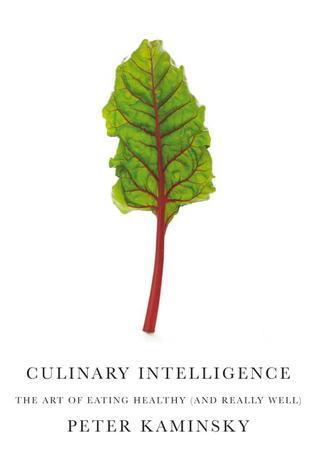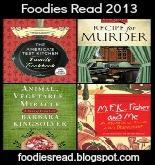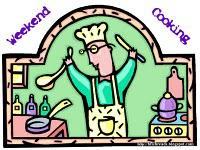Book: Culinary Intelligence: The Art of Eating Healthy (and Really Well) by Peter Kaminsky
Genre: Cooking
Publisher: Alfred A. Knopf
Publication date: 2012
Pages: 258
Source: Library
 Summary: In Culinary Intelligence, columnist and author Peter Kaminsky approaches the quest for healthy eating by focusing on the quailty of the food we eat.
Summary: In Culinary Intelligence, columnist and author Peter Kaminsky approaches the quest for healthy eating by focusing on the quailty of the food we eat.
Good cooking with real ingredients is the only way to eat a healthy, satisfying diet. Some authorities may not be so insistent on this point. I see no other way. (p. 20)
The central concept of Flavor per Calorie makes developing Culinary Intelligence a matter of attentiveness, mostly, aided by some knowledge acquired along the way about calories and even more about what maximizes flavors of foods. Flavor per Calorie, of course, begins with great ingredients, so there’s a whole chapter on that. I was intrigued by the next chapter called “The Fundamentals of Flavor: The Elements of Taste” because it helped me develop a vocabulary of flavor — if I can talk or write about something, it’s much easier for me to be attentive to it.
Chapters on cooking, meals, and dining out bring the Flavor per Calorie concept to practical use in the choices we make each day about what we eat. This is not a cookbook, but Fourteen Recipes in the appendix illustrate the concepts from earlier in the book.
Thoughts: As I transition into weight maintenance after losing 70 pounds since August of 2009, I’m beginning to realize that I may need to pay more attention to what I eat rather than less — improve my awareness of taste, take my cooking skills to the next level, and be more adventurous.
One adventure that Kaminsky encouraged me to pursue is in the sea of little fish. Raised in the Midwest, I’ve always been a seafood skeptic. Just when I finally taught myself to appreciate a slab of seared tuna or grilled salmon, things got complicated with mercury levels, fish factory farms, and over-harvesting. I actually ate fewer meals featuring fish as my diet improved. Here’s a fast path through the confusion that I hadn’t thought of:
What tend to get overlooked, in environmental discussions and in cookbooks, are the little fish: sardines, anchovies, herring, and the like are delicious, plentiful, and loaded with heart-healthy omega-3′s and satiety-inducing umami. Furthermore, because they are lower down on the food chain, their tissues accumulate less mercury and other harmful substances; when big fish eat little fish, they also consume and store many of the pollutants that the little fish ate. Fresh, canned, or cured, these little guys are available everywhere all year round. (p. 88)
Now, as a lifelong seafood skeptic, I don’t expect myself to suddenly start popping sardines out of a tin and dropping them in my mouth like a fratboy swallowing goldfish. But I am open to the idea of using little fish in recipes.
For my first adventure, I used one of the Fourteen Recipes in the back of Culinary Intelligence — Pasta Pete-a-nesca, a variation of puttanesca sauce for pasta, a tomato sauce with anchovies. I wouldn’t have guessed there was seafood in it if I hadn’t opened the tin myself. We loved it — unfortunately, it was way too much salt for our current way of eating. Does anyone know of a no-salt-added anchovy brand for us to try? Or do you have a recipe for sardines or herring that a mildly reluctant seafood eater might enjoy?
Appeal: This book follows quite naturally on the heels of In Defense of Food by Michael Pollan and Food Matters by Mark Bittman. What Culinary Intelligence adds to those is the kind of appreciation for taste that you would expect from a wine connoisseur or food critic. If you crossed In Defense of Food with Zingerman’s Guide to Good Eating, you’d get Culinary Intelligence.
Other Reviews: This book hasn’t made the round of book blogs yet, so I must have heard of it somewhere else. Oh, I know — Marion Nestle’s Food Politics blog: Weekend reading: food as an art.
 Challenges: This is my first book for Foodies Read 2013. In 2012, I challenged myself to read 19 food books (Cordon Bleu Chef level) and only made it to 15, so this year, I will challenge myself to read 14 to 18 books (Chef de Cuisine level).
Challenges: This is my first book for Foodies Read 2013. In 2012, I challenged myself to read 19 food books (Cordon Bleu Chef level) and only made it to 15, so this year, I will challenge myself to read 14 to 18 books (Chef de Cuisine level).
 Weekend Cooking is hosted each week at Beth Fish Reads. Check out today’s post for more adventures in cooking and eating.
Weekend Cooking is hosted each week at Beth Fish Reads. Check out today’s post for more adventures in cooking and eating.

